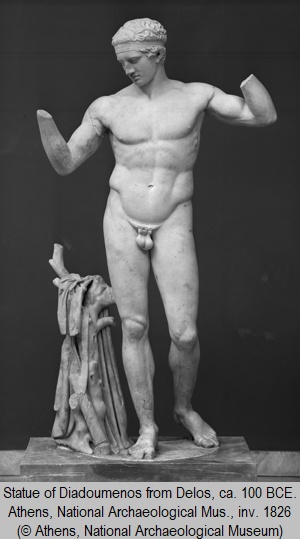 Large-scale marble versions of widespread sculptural types dominate the corpus of Roman Idealplastik. The prevalence of these objects in the archaeological record is owing to the loss of many bronze artefacts in the course of history, most of which were melted and reused for other projects. It is also owing to the more efficient strategies for management and distribution of marble in the first and second centuries CE. These led to an increase in marble production and greater availability throughout the Mediterranean of larger blocks of marble. Certainly, many surviving Roman replica series derive from lost earlier bronze prototypes. Still, to better understand seriality in Roman sculpture, we must move beyond the simplistic dichotomy between lost Greek bronze originals and Roman marble copies, on which debate has focused for over two and a half centuries.
Large-scale marble versions of widespread sculptural types dominate the corpus of Roman Idealplastik. The prevalence of these objects in the archaeological record is owing to the loss of many bronze artefacts in the course of history, most of which were melted and reused for other projects. It is also owing to the more efficient strategies for management and distribution of marble in the first and second centuries CE. These led to an increase in marble production and greater availability throughout the Mediterranean of larger blocks of marble. Certainly, many surviving Roman replica series derive from lost earlier bronze prototypes. Still, to better understand seriality in Roman sculpture, we must move beyond the simplistic dichotomy between lost Greek bronze originals and Roman marble copies, on which debate has focused for over two and a half centuries.There is a large corpus of items belonging to widespread series that are made of other substances. This material invites a conversation about the sculptor’s choice of material. These choices can have a wide range of meanings and hence an understanding of them could prove informative. In the case of miniature versions of widespread types, both inexpensive materials, such as clay, and more precious materials, such as ivory, rock crystal or other rare stones, were used. This allowed sculptors to meet the demands of two different kinds of customer, catering to both a large market with limited means, and the most affluent elite. These objects provide exceptional insight into the sophisticated interplay of subject, iconography, type, and matter in Roman sculpture.
The use of coloured stones as material for full-size carved statues is another instance of skilful exploitation of the material with respect to its perceived qualities and economic value. Such use was a widespread feature of Roman sculpture starting with the early imperial period. For instance, the dark reflective surfaces of basanite statues allow them to encapsulate multiple layers of meaning. They emulate the substance of bronze, with its calligraphic surface treatment and inlays, the old age associated with a dark patina, and the exoticness of the Egyptian tradition. With familiar types, the choice of an uncommon material may complicate the relationship of the statue both with its putative model and with other items in the series. This relationship is even more complex in the cases of gilded sculptures and those with painted polychromy. The choice to paint or gild the statue taps into broader discourses about the value and contrasting physical qualities of artistic materials, and hence may highlight or curtail the reference to the content of a prototype, while retaining its shape.
Recognition of technological and material qualities facilitates multiple comparisons, both to the alleged prototype and to similar works. This paper analyses a small set of case studies, and through them develops a twofold perspective. I seek to retain the comparative approach at the core of traditional Kopienkritik while considering each artwork within its distinctive architectural and cultural context. I address both the ‘vertical’ diachronic relationship between a work of art and its model, and the ‘horizontal’ synchronic relationships within the replica series.
e-mail: anna.anguissola@unipi.it
This article should be cited like this: A. Anguissola, Material Translations: Roman Ideal Sculpture and the Fabric of Seriality, Forum Archaeologiae 98/III/2021 (http://farch.net).